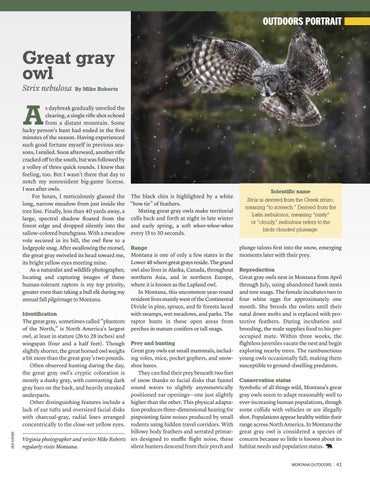OUTDOORS PORTRAIT
Great gray owl Strix nebulosa
By Mike Roberts
ZACK CLOTHIER
A
s daybreak gradually unveiled the clearing, a single rifle shot echoed from a distant mountain. Some lucky person’s hunt had ended in the first minutes of the season. Having experienced such good fortune myself in previous seasons, I smiled. Soon afterward, another rifle cracked off to the south, but was followed by a volley of three quick rounds. I knew that feeling, too. But I wasn’t there that day to notch my nonresident big-game license. I was after owls. For hours, I meticulously glassed the The black chin is highlighted by a white long, narrow meadow from just inside the “bow tie” of feathers. Mating great gray owls make territorial tree line. Finally, less than 40 yards away, a large, spectral shadow floated from the calls back and forth at night in late winter forest edge and dropped silently into the and early spring, a soft whoo-whoo-whoo sallow-colored bunchgrass. With a meadow every 15 to 30 seconds. vole secured in its bill, the owl flew to a lodgepole snag. After swallowing the morsel, Range the great gray swiveled its head toward me, Montana is one of only a few states in the Lower 48 where great grays reside. The grand its bright yellow eyes meeting mine. As a naturalist and wildlife photographer, owl also lives in Alaska, Canada, throughout locating and capturing images of these northern Asia, and in northern Europe, human-tolerant raptors is my top priority, where it is known as the Lapland owl. In Montana, this uncommon year-round greater even than taking a bull elk during my resident lives mainly west of the Continental annual fall pilgrimage to Montana. Divide in pine, spruce, and fir forests laced with swamps, wet meadows, and parks. The Identification The great gray, sometimes called “phantom raptor hunts in these open areas from of the North,” is North America’s largest perches in mature conifers or tall snags. owl, at least in stature (26 to 28 inches) and wingspan (four and a half feet). Though Prey and hunting slightly shorter, the great horned owl weighs Great gray owls eat small mammals, includa bit more than the great gray’s two pounds. ing voles, mice, pocket gophers, and snowOften observed hunting during the day, shoe hares. They can find their prey beneath two feet the great gray owl’s cryptic coloration is mostly a dusky gray, with contrasting dark of snow thanks to facial disks that funnel gray bars on the back, and heavily streaked sound waves to slightly asymmetrically positioned ear openings—one just slightly underparts. Other distinguishing features include a higher than the other. This physical adaptalack of ear tufts and oversized facial disks tion produces three-dimensional hearing for with charcoal-gray, radial lines arranged pinpointing faint noises produced by small concentrically to the close-set yellow eyes. rodents using hidden travel corridors. With billowy body feathers and serrated primarVirginia photographer and writer Mike Roberts ies designed to muffle flight noise, these silent hunters descend from their perch and regularly visits Montana.
Scientific name Strix is derived from the Greek strizo, meaning “to screech.” Derived from the Latin nebulosos, meaning “misty” or “cloudy,” nebulosa refers to the birds clouded plumage. plunge talons first into the snow, emerging moments later with their prey. Reproduction Great gray owls nest in Montana from April through July, using abandoned hawk nests and tree snags. The female incubates two to four white eggs for approximately one month. She broods the owlets until their natal down molts and is replaced with protective feathers. During incubation and brooding, the male supplies food to his preoccupied mate. Within three weeks, the flightless juveniles vacate the nest and begin exploring nearby trees. The rambunctious young owls occasionally fall, making them susceptible to ground-dwelling predators. Conservation status Symbolic of all things wild, Montana’s great gray owls seem to adapt reasonably well to ever-increasing human populations, though some collide with vehicles or are illegally shot. Populations appear healthy within their range across North America. In Montana the great gray owl is considered a species of concern because so little is known about its habitat needs and population status. MONTANA OUTDOORS
41
